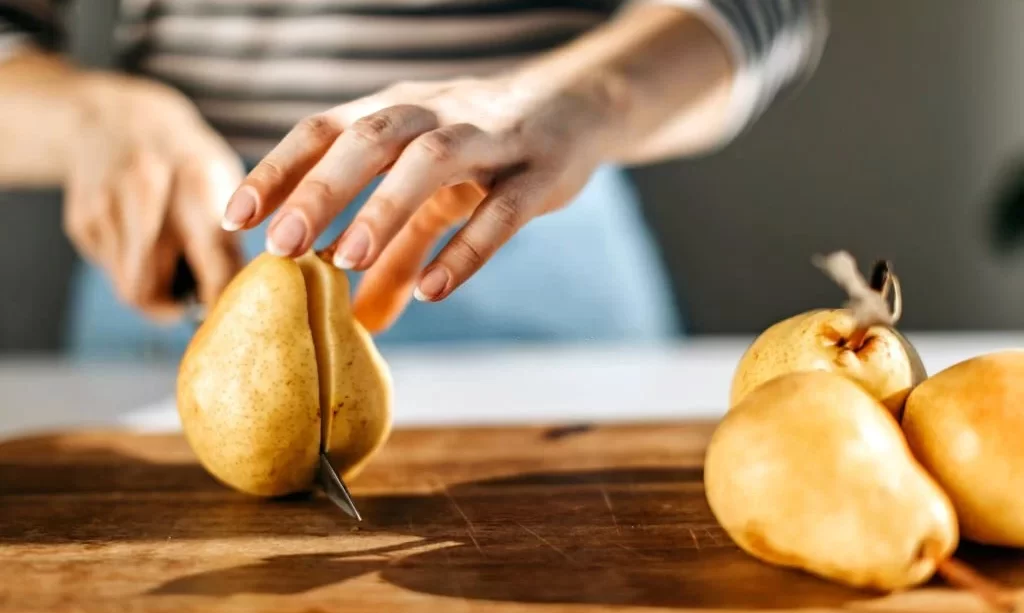Pears, with their juicy and sweet flesh, are a delightful addition to any meal or snack. These versatile fruits are not only delicious but also packed with essential nutrients. Whether enjoyed fresh, added to salads, or baked into delectable desserts, pears have a unique flavor and texture that make them a favorite among many. However, before you can savor the succulent taste of pears, you need to know how to properly select and prepare them.
In this guide, we embark on a journey to demystify the art of cutting pears. We’ll provide you with step-by-step instructions on how to cut pears for various culinary purposes, from snacks to salads and more. But before we dive into the cutting techniques, let’s begin with the crucial first step: selecting ripe pears that promise the best flavor and texture.
- 5lb box contains 5-7 premium pears
Selecting Ripe Pears
Choosing the right pears is essential to ensure that your culinary endeavors with these fruits yield the best results. Ripe pears are not only more flavorful but also have the ideal texture for various recipes. Here’s how to select ripe pears:
- Color: Check the color of the pear’s skin. While the color can vary depending on the variety, ripe pears typically exhibit a change in skin color from bright green to a more golden or yellow hue. However, some varieties, like Bartlett pears, become entirely yellow when ripe.
- Aroma: Gently sniff the stem end of the pear. A ripe pear should have a sweet, fragrant aroma that is noticeable but not overpowering. If it smells slightly sweet, it’s a good indicator of ripeness.
- Texture Near the Stem: Press your thumb near the stem end of the pear. It should yield slightly to gentle pressure without feeling too soft or mushy. Avoid pears with bruised or overly soft spots.
- Check the Neck: For pears like the Bartlett variety, which change color as they ripen, focus on the neck area. If it yields to gentle pressure when pressed near the neck, it’s ready to eat.
- Feel for Uniformity: A ripe pear should have a consistent firmness throughout. Avoid pears that are hard on one end and overly soft on the other, as this may indicate uneven ripening.
By following these guidelines for selecting ripe pears, you’ll set the stage for a delightful culinary experience. Whether you plan to enjoy pears as a healthy snack or incorporate them into your favorite recipes, starting with ripe fruit ensures that you’ll savor their natural sweetness and juiciness to the fullest.
Tools You’ll Need
Before you embark on the journey of cutting and preparing pears, it’s essential to gather the necessary tools and utensils. Having the right equipment on hand will not only make the process more efficient but also ensure safety. Here are the basic tools you’ll need for cutting pears:
- Cutting Board: Use a clean and stable cutting board with a non-slip surface. This provides a safe and hygienic workspace.
- Chef’s Knife: A sharp chef’s knife is the primary tool for slicing and dicing pears. Choose a knife with a comfortable handle and a blade long enough to cut through the pear’s flesh.
- Paring Knife: A paring knife is useful for removing the core and making precise cuts, such as when creating intricate pear garnishes.
- Spoon: A regular tablespoon or a melon baller can be handy for scooping out the core and seeds from the pear halves.
- Paper Towels or Clean Cloth: These are essential for drying the pears after washing and for keeping your hands and work surface clean.
- Lemon Juice (Optional): Lemon juice can be used to prevent cut pears from browning due to exposure to air. It adds a subtle tangy flavor and helps maintain the pear’s fresh appearance.
Gathering these tools before you begin will make the process of cutting and preparing pears more efficient and enjoyable. Additionally, make sure your knives are sharp for clean and precise cuts.
- MUTI-PURPOSE CHEF KNIFE SET – The Brewin 3pc Professional Kitchen Knife Set comes with 1× chef’s knife, 1× santoku knife, and 1x utility knife and will be your best cooking mate. The knife set can easily handle all your daily kitchen tasks as the versatile knives let you enjoy cutting, carving, slicing, chopping, and mincing meat, fruits, vegetables, and more. This luxurious Brewin boxed carving knife set is the best gift for your loved ones.
- RAZOR SHARP WITH DURABLE EDGES – Sharpness is the key word for cutting knives. The razor-sharp edge is engineered with a 56+ Rockwell hardness score and is hand polished by our experienced craftsmen at 14-16 degrees per side. The combination of maximum sharpness and edge retention ensures precise and effortless cutting every time, even left-handed. DO NOT test the sharpness by touching the blade with your hand.
- FULL TANG ERGONOMIC HANDLE – Triple-riveted ABS ergonomic handle with fully-forged full tang yields optimal balance, strength, stability, and durability. The extra-wide design between index and middle finger provides the most comfortable and non-slip grip, The full bolster with a finely polished spine protects your fingers from sharp edges and ensures a more suitable pinch grip.
- STAIN RESISTANT AND EASY TO WASH – Brewin chef’s knives are crafted from high-carbon 1.4116 German stainless steel engineered to perfection for rust and stain resistance, providing an excellent balance between long-lasting sharpness and durability. Hand wash the knives with dishwashing soap and dry them with a towel to maintain the knives’ quality.
- 100% SATISFACTION OR MONEY-BACK GUARANTEE – Brewin strives to ensure complete customer satisfaction with every knife. If you’re not satisfied with what you received, you can either return it or request a replacement. If you have any other issues, feel free to contact us, we will reply immediately and do our best to solve your problem.
Wash and Prepare
Now that you have your tools ready, it’s time to prepare the pears for cutting. Properly washing and handling the pears ensures that they are clean and ready for culinary use. Follow these steps:
- Wash Your Hands: Start by washing your hands thoroughly with soap and warm water. Clean hands are crucial for food safety.
- Rinse the Pears: Place the pears under running cold water. Use your hands or a soft brush to gently scrub the skin and remove any dirt or residue. Ensure that you wash all sides of the pear.
- Pat Dry: After washing, use paper towels or a clean cloth to pat the pears dry. This helps remove excess moisture and makes them easier to handle.
- Check for Bruises: While drying, inspect the pears for any bruises, blemishes, or imperfections on the skin. If you find any, you can trim them away with a knife.
With your pears clean and dry, you’re now ready to proceed with cutting and preparing them for your chosen culinary endeavors. Whether you’re creating a fresh fruit salad, adding pears to a savory dish, or simply enjoying them as a snack, the proper preparation sets the stage for a delicious experience.
How to Cut a Whole Pear
Cutting a whole pear is a fundamental skill that opens up a world of culinary possibilities. Whether you want to create slices, wedges, or cubes, mastering the technique of cutting a whole pear is essential. Here’s a step-by-step guide:
- Start with a Ripe Pear: Begin with a ripe pear, as discussed in previous paragraphs. A ripe pear is not only easier to cut but also more flavorful.
- Wash and Dry: If you haven’t already, wash and dry the pear following the instructions in our previous paragraphs.
- Slice Off the Top: Place the pear on your cutting board and use a sharp chef’s knife to slice off the top, just below the stem. This creates a flat, stable surface.
- Slice Off the Bottom: Similarly, slice off a small portion from the bottom of the pear to create a flat base. This ensures that the pear stands securely.
- Vertical Halves: With the pear standing upright, carefully cut it vertically in half from top to bottom. This will yield two equal pear halves.
- Remove the Core (Optional): If you prefer to remove the core, use a paring knife or a spoon to scoop out the seeds and the tough, fibrous center from each pear half.
- Slice, Wedge, or Cube: Once you have pear halves, you can proceed to create your desired cuts. For slices, make thin or thick cuts horizontally. For wedges, slice each half into several equal segments. For cubes, make parallel cuts in both directions.
- Enjoy: Your sliced, wedged, or cubed pears are now ready to be enjoyed in salads, desserts, or as a refreshing snack.
How to Remove the Core
Removing the core from a pear is an optional step, depending on your culinary preferences and the dish you’re preparing. Here’s how to easily remove the core from a pear:
- Start with a Halved Pear: Begin with a pear that has been halved vertically, as described in the previous section.
- Identify the Core: Locate the tough, fibrous core running down the center of each pear half. This is what you’ll want to remove.
- Use a Paring Knife: Take a paring knife and carefully angle it toward the core at the base of the pear half. Insert the knife just beside the core.
- Cut Along the Core: With a gentle sawing motion, cut along the side of the core, following its shape. Be cautious not to cut too deeply into the flesh, as you want to remove the core while preserving as much pear as possible.
- Repeat on the Other Side: Flip the pear half and repeat the process to remove the other side of the core. You should now have a pear half with a core-free center.
- Inspect and Trim: After removing the core, inspect the pear to ensure that all tough parts have been removed. Trim any remaining bits if necessary.
- Repeat for the Other Half: Follow the same steps to remove the core from the other pear half.
With the core removed, your pear halves are now ready to be sliced, wedged, or cubed, depending on your culinary plans. This technique not only enhances the texture of your pear dishes but also ensures a more enjoyable dining experience.
How to Slice Pear Halves
Slicing pear halves is a versatile way to prepare this delightful fruit for various dishes, whether you’re creating a fruit platter, a salad, or a garnish. Here’s a step-by-step guide on how to slice pear halves:
- Prepare Halved Pears: Start with pear halves that have been cut and optionally had their cores removed, following the steps in Section 4 and Section 5.
- Place the Pear Halves Flat: Lay the pear halves flat side down on your clean cutting board. The flat side provides stability for slicing.
- Choose Your Thickness: Decide on the thickness of your slices. You can opt for thin slices for delicate presentations or thicker slices for a more substantial bite.
- Begin Slicing: Using a sharp chef’s knife, carefully make even, straight cuts across the pear half, starting from the wide end (where the stem was) and moving toward the narrow end. Ensure consistent thickness for all slices.
- Mindful Pressure: Apply gentle, even pressure as you slice to create uniform pieces. Take your time and exercise caution to maintain control over the knife.
- Repeat for the Other Half: Once you’ve sliced one pear half, repeat the process for the other half. Ensure that the slices are of similar thickness for a balanced presentation.
- Arrange and Serve: Arrange your pear slices as desired on a plate, in a salad, or alongside other fruits. You can fan them out for an elegant display or keep them stacked for a more casual presentation.
How to Dice Pears
Diced pears are a versatile addition to various recipes, from salsas and chutneys to desserts and oatmeal. Here’s a step-by-step guide on how to dice pears:
- Prepare Halved Pears: Start with pear halves that have been cut and optionally had their cores removed, following the steps in Section 4 and Section 5.
- Place the Pear Halves Flat: Lay the pear halves flat side down on your clean cutting board.
- Choose Your Dice Size: Decide on the size of the dice you want. Common options include small dice (approximately 1/4 inch), medium dice (approximately 1/2 inch), or larger dice (approximately 3/4 inch). The choice depends on your recipe.
- Slice Vertically: Starting from the wide end (where the stem was), make vertical cuts down the length of the pear, creating slices. Ensure that the width of the slices matches the desired dice size.
- Stack the Slices: Gather several slices together, aligning them neatly to form a stack.
- Make Horizontal Cuts: With the stack of slices, make even horizontal cuts perpendicular to your vertical slices, creating cubes or dice. Maintain a consistent width for uniform pieces.
- Repeat for the Other Half: Once you’ve diced one pear half, repeat the process for the other half.
- Collect and Use: Transfer the diced pears to a bowl or your cooking vessel, ready to be used in your chosen recipe.
Sliced and diced pears add a burst of sweetness and freshness to your culinary creations. Whether you’re enhancing a savory dish or creating a delightful dessert, mastering these techniques ensures that your pear-based dishes not only taste delicious but also look visually appealing.
Presentation and Serving Suggestions
How you present and serve your cut pears can elevate the dining experience and make your dishes even more appealing. Here are some presentation and serving suggestions to inspire your culinary creativity:
- Fruit Platter: Arrange slices or wedges of pears alongside other fresh fruits like apples, grapes, and berries for a colorful and inviting fruit platter.
- Salads: Add sliced or diced pears to green salads for a burst of sweetness and a refreshing contrast to savory ingredients. Pears pair wonderfully with ingredients like spinach, arugula, goat cheese, and nuts.
- Cheese Boards: Pair sliced pears with a variety of cheeses, such as brie, blue cheese, or cheddar, for an elegant cheese board that balances flavors and textures.
- Desserts: Use sliced or diced pears as a topping for desserts like yogurt parfaits, ice cream sundaes, or pancakes. They also make a delicious addition to fruit tarts and galettes.
- Garnish: Use finely sliced or diced pears as a garnish for cocktails, mocktails, or savory dishes like roasted meats or seafood.
- Chutneys and Relishes: Create flavorful chutneys or relishes with diced pears, spices, and herbs to accompany grilled or roasted dishes.
- Smoothies: Blend pears into smoothies with yogurt, spinach, and honey for a nutritious and naturally sweet drink.
- Breakfast: Top your morning cereal or oatmeal with sliced pears for a wholesome and satisfying breakfast.
- Fruit Skewers: Thread pear slices onto skewers with other fruits for a fun and portable snack or party appetizer.
Storing Cut Pears
Properly storing cut pears ensures that they remain fresh and appetizing for future use. Here’s how to store cut pears:
- Refrigeration: If you’ve cut more pears than you plan to consume immediately, place the cut pieces in an airtight container or resealable bag. Store them in the refrigerator to keep them fresh for up to 2-3 days.
- Lemon Juice: To prevent cut pears from browning due to exposure to air, you can sprinkle them lightly with lemon juice before storing. Lemon juice’s acidity helps maintain their color and freshness.
- Sealing: Ensure that the container or bag is sealed tightly to prevent moisture loss and exposure to other odors in the fridge.
- Use within a Reasonable Time: While cut pears can be stored, they are best when enjoyed fresh. Try to use them within a few days to enjoy their peak flavor and texture.
Conclusion
In conclusion, cutting and preparing pears is a simple yet rewarding culinary skill that opens up a world of delicious possibilities. Whether you’re incorporating them into salads, desserts, or savory dishes, knowing how to cut pears properly ensures that you can enjoy their natural sweetness and juiciness to the fullest.
Starting with ripe pears, as discussed in Section 1, and using the right tools, as detailed in Section 2, sets the stage for a successful culinary experience. The step-by-step guides in Sections 4, 5, 6, and 7 provide you with the techniques to create slices, wedges, or cubes, depending on your desired outcome.
Remember that presentation and serving, as outlined in Section 8, can enhance the appeal of your pear-based dishes, making them not only delicious but also visually enticing. And when it comes to storing cut pears, following the guidelines in Section 9 ensures that you can enjoy their freshness even after they’ve been prepared.
Whether you’re enjoying pears as a healthy snack, a flavorful addition to a salad, or a delightful dessert, mastering the art of cutting pears allows you to savor their natural goodness in countless culinary creations. So, grab your favorite pears and embark on a culinary adventure filled with sweet, juicy, and satisfying moments.





